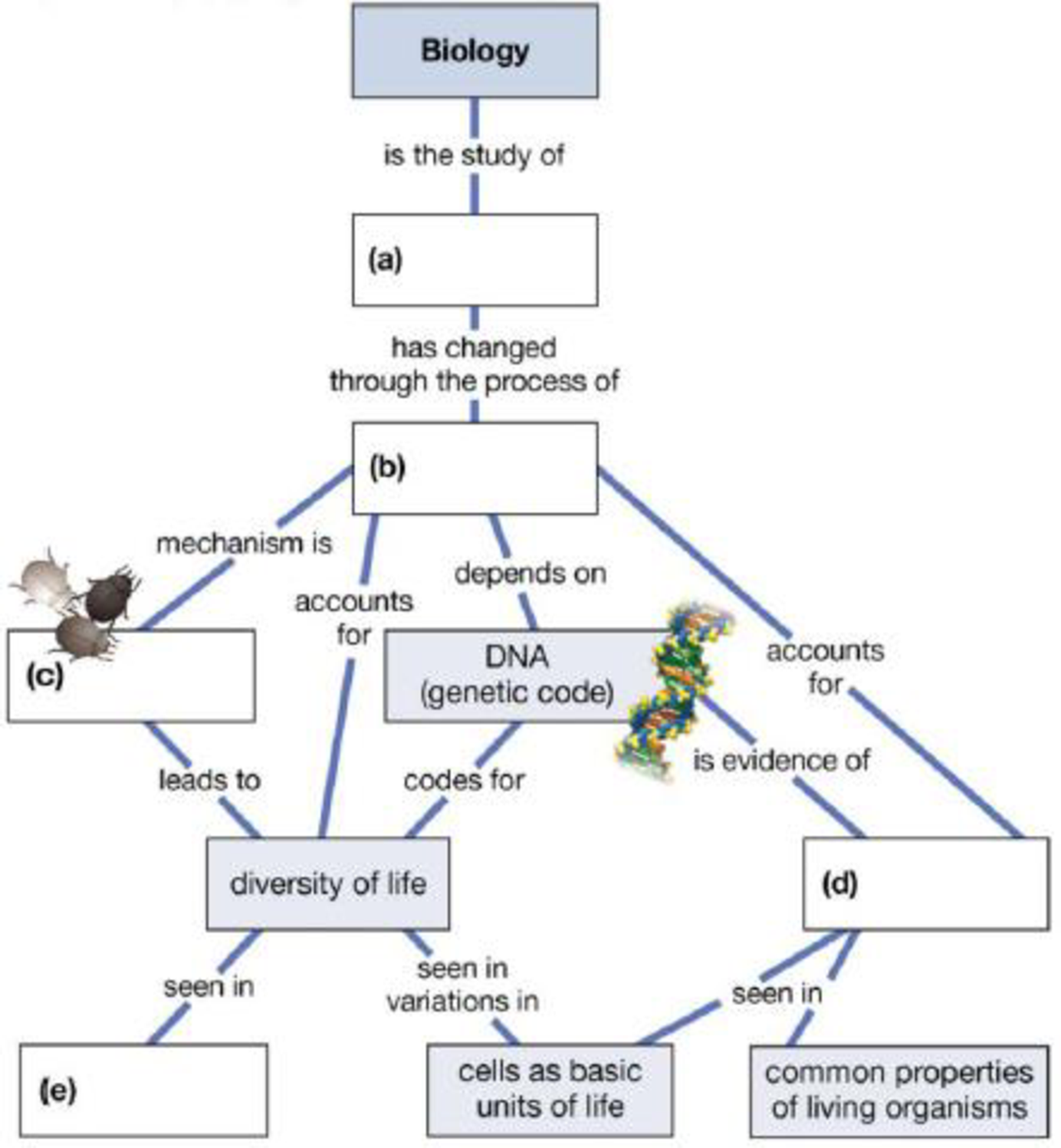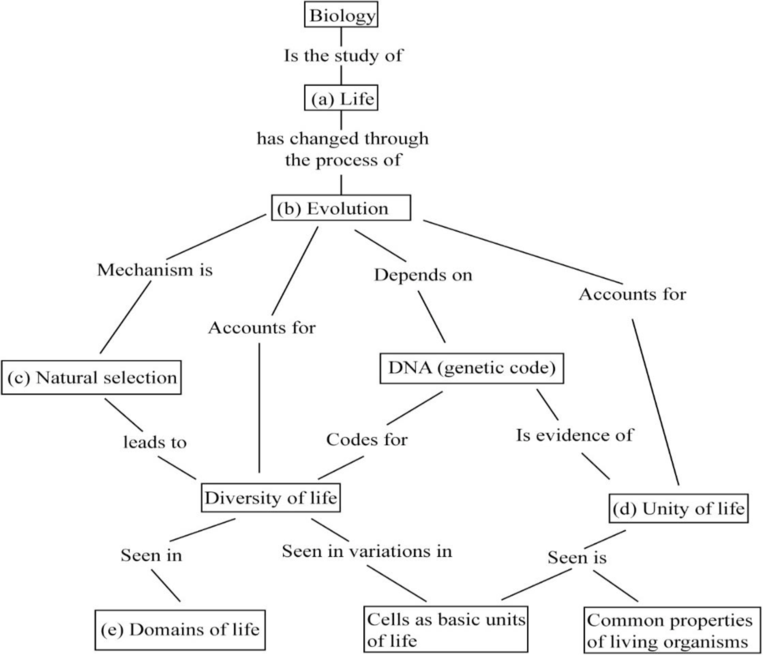
Concept explainers
Complete the following map organizing one of biology’s major themes.

To complete: The given map showing a major biological theme.
Introduction: The five major themes present in all biological systems are as follows:
Theme 1: “Evolution is the core theme of biology”.
Theme 2: “Life depends on the flow of information”.
Theme 3:“Structure and functions are related”.
Theme 4: “Life depends on the transfer and transformation of energy and matter”.
Theme 5: “Life depends on interactions within and between systems”.
Answer to Problem 1CC
Fig. 1 shows the completed map of evolution, one of the core themes in biology given in the textbook.
Pictorial representation: Fig. 1 shows the completed map of the core theme of biology: evolution.

Fig.1 Evolution as a core theme of biology
Explanation of Solution
(a)
Correct answer: Life
The term “biology” is defined as the branch of science that studies life (in Greek: bio= life; -ologia= study of). Hence, the correct answer is life.
(b)
Correct answer: Evolution
Evolution is defined as the continuous process of changes that have occurred over a long time to transform the living beings from their earliest simplest forms to the present-day wide variety of species. It can be summarized as “descent with modification”, that is, all species have evolved from common ancestors through several continuous changes over time. Thus, evolution is the process that has changed life. Hence, the correct answer is evolution.
(c)
Correct answer: Natural selection
Researcher Charles Darwin proposed the phenomenon of “natural selection” as the mechanism for evolution. In a large population of species, individuals show several variations in their traits; out of which, some variations are more favorable for survival, utilization of resources, and better reproductive success of selected individuals. This phenomenon of better adaptation, survival, and reproductive success of selected individuals due to the presence of certain traits or variations is called natural selection. These selected individuals are able to pass their traits to their next generation, and thus their population increases, slowly by transforming the population, leading to evolution. Thus, natural selection is the mechanism that drives evolution. Hence, the correct answer is natural selection.
(d)
Correct answer: Unity of life
Deoxyribonucleic acid (DNA) is present in most of the living organisms that help in the flow of information from one generation to the other and changes in which lead to evolution. Thus, it is a proof for unity among all life forms.
Evolution has led to the development of various species from a common ancestor through continuous changes. Thus, it shows unity among all life forms. Genetic code as DNA and evolution show unity of life. Hence, the correct answer is unity of life.
(e)
Correct answer: Domains of life
DNA that encodes the genetic information is present in most of the living organisms classified into various domains of life. There are a large number of organisms of various types from simple single-celled bacteria to highly complex and multicellular animals. The basis of their diversity is the genetic information coded in their genetic material, usually DNA. Differences in DNA sequences cause diversity among organisms belonging to different domains of life. Hence, the correct answer is domains of life.
Want to see more full solutions like this?
Chapter 1 Solutions
CAMP.BIO:CONC...MOD.MAST+PRINT>I<
- Describe and give a specific example of how successionary stage is related to species diversity?arrow_forwardExplain down bellow what happens to the cell in pictures not in words: Decreased pH in mitochondria Increased ATP Decreased pH in cytosol Increased hydrolysis Decreasing glycogen and triglycerides Increased MAP kinase activity Poor ion transport → For each one:→ What normally happens?→ What is wrong now?→ How does it mess up the cell?arrow_forward1.) Community Diversity: The brown and orange line represent two different plant communities. a. Which color represents the community with a higher species richness? b. Which color represents the community with a higher species evenness? Relative abundance 0.1 0.04 0.001 2 4 6 8 10 12 14 16 18 20 22 24 Rank abundance c. What is the maximum value of the Simpson's diversity index (remember, Simpson's index is D = p², Simpson's diversity index is 1-D)? d. If the Simpson's diversity index equals 1, what does that mean about the number of species and their relative abundance within community being assessed?arrow_forward
- 1.) Community Diversity: The brown and orange line represent two different plant communities. a. Which color represents the community with a higher species richness? b. Which color represents the community with a higher species evenness? Relative abundance 0.1 0.04 0.001 2 4 6 8 10 12 14 16 18 20 22 24 Rank abundance c. What is the maximum value of the Simpson's diversity index (remember, Simpson's index is D = p², Simpson's diversity index is 1-D)? d. If the Simpson's diversity index equals 1, what does that mean about the number of species and their relative abundance within community being assessed?arrow_forwardwhat measures can a mother to take to improve the produce of her to milk to her newborn baby ?arrow_forward1. Color the line that represents all ancestors of the Eastern white pine tree green (but only the ancestral line NOT shared with other organisms) 2. Oncle the last common ancestor of the Colorado blue spruce tree and Eastern white pine tree. 3. Put a box around the last common ancestor of the sugar maple tree and the dogwood tree. 4. Put a triangle around the last common ancestor of the red pine tree and the american holly bush. 5. Color the line that represents all ancestors of the Ponderosa pine tree red (including all shared ancestors). 6. Color the line that represents all ancestors of the American elm tree blue (including all shared ancestors). 7 Color the line that represents all ancestors of the Sabal palm tree purple (including all shared ancestors) 8. Using a yellow highlighter or colored pencil, circle the clade that includes all pine trees. 9. Using a orange highlighter or colored pencil, circle the clade that includes all gymnosperms 10. Can you tell…arrow_forward
- You have been hired as a public relations specialist to give invertebrates a good name. After all, they are much more than just creepy crawly bugs! Your first task though is to convince yourself that is true. The best way to do that is to start close to home. Find something in your house that is a product obtained directly from an invertebrate or only due to an invertebrate’s actions. Describe the product, its function and utility, as well as any human manufactured alternatives. Be sure to highlight the advantages of obtaining this directly from nature. Keep in mind, a product can be something you use, wear, eat, or enjoy for its visual appeal.arrow_forwardUse the following tree diagram to answer Questions #8-10. 8) Which of the following two animals are the most closely related based on the tree to the left? a) Pig and camel b) Hippo and pig c) Deer and cow 9) CIRCLE on the tree diagram where the common ancestor between a hippo and a cow is. 10) Put a SQUARE on the tree diagram where the common ancestor between a pig and a peccary is.arrow_forwardExplain: Healthy Cell Function Overview→ Briefly describe how a healthy cell usually works: metabolism (ATP production), pH balance, glycogen storage, ion transport, enzymes, etc. Gene Mutation and Genetics Part→ Focus on the autosomal recessive mutation and explain: How gene mutation affects the cell. How autosomal inheritance works. Compare the normal and mutated gene sequences simply. → Talk about possible consequences of a faulty hydrolytic enzyme.arrow_forward
- Can you fill out those termsarrow_forwardExplain down bellow what happens to the cell: Decreased pH in mitochondria Increased ATP Decreased pH in cytosol Increased hydrolysis Decreasing glycogen and triglycerides Increased MAP kinase activity Poor ion transport → For each one:→ What normally happens?→ What is wrong now?→ How does it mess up the cell?arrow_forwardAn 1100 pound equine patient was given 20 mg/kg sucralfate 3 times a day, 2.8 mg/kg famotidine twice a day, and 10mg/kg doxycycline twice a day. Sucralfate comes as a 1 gm tablet, famotidine as 20 mg tablets, and doxycycline as 100mg tablets. All are in bottles of 100 tablets.How many total mg are needed for the patient and how many tablets of each would be needed to provide each dose?How many bottles of each would be needed to have available if this patient were to be on this drug regimen for 5 days?arrow_forward
 Concepts of BiologyBiologyISBN:9781938168116Author:Samantha Fowler, Rebecca Roush, James WisePublisher:OpenStax College
Concepts of BiologyBiologyISBN:9781938168116Author:Samantha Fowler, Rebecca Roush, James WisePublisher:OpenStax College Human Biology (MindTap Course List)BiologyISBN:9781305112100Author:Cecie Starr, Beverly McMillanPublisher:Cengage LearningEssentials Health Info Management Principles/Prac...Health & NutritionISBN:9780357191651Author:BowiePublisher:Cengage
Human Biology (MindTap Course List)BiologyISBN:9781305112100Author:Cecie Starr, Beverly McMillanPublisher:Cengage LearningEssentials Health Info Management Principles/Prac...Health & NutritionISBN:9780357191651Author:BowiePublisher:Cengage Biology 2eBiologyISBN:9781947172517Author:Matthew Douglas, Jung Choi, Mary Ann ClarkPublisher:OpenStax
Biology 2eBiologyISBN:9781947172517Author:Matthew Douglas, Jung Choi, Mary Ann ClarkPublisher:OpenStax Biology Today and Tomorrow without Physiology (Mi...BiologyISBN:9781305117396Author:Cecie Starr, Christine Evers, Lisa StarrPublisher:Cengage Learning
Biology Today and Tomorrow without Physiology (Mi...BiologyISBN:9781305117396Author:Cecie Starr, Christine Evers, Lisa StarrPublisher:Cengage Learning





